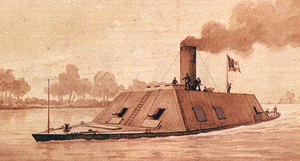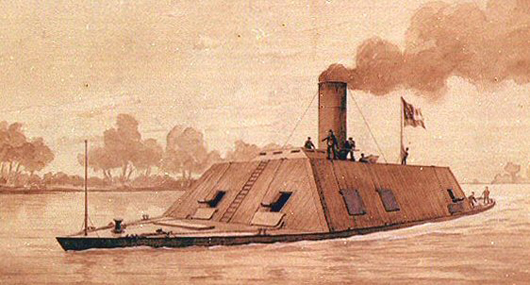
COLUMBUS, Miss. (AP) – “You can draw military maps and say this happened here and that happened there, and the result is ‘this’—but that doesn’t tell us what it was like to march 40 miles a day in the dead of winter,” Dr. Brandon Beck said.
“It doesn’t tell us about the pain, the privation, hardship, the worry and agony,” he said.
The Civil War historian writes at a small round antique table in his Columbus home. His spindle-backed chair bears the seal of Shenandoah University in Winchester, Va., where he taught for 23 years and still serves as director of the McCormick Civil War Institute and is emeritus professor of history.
“There’s an old-fashioned word, seldom heard any more outside of church,” he said. “It’s glory. … There were great men, great women and great events … there was glory aplenty in the Civil War. And they were doing it for nothing but home.”
Beck’s ninth book, Holly Springs: Van Dorn, the CSS Arkansas and the Raid that Saved Vicksburg, is the result of more than two years of research.
The result is a compelling, concise account of the colorful Confederate Major Gen. Earl Van Dorn’s raid at Holly Springs in December 1862. That ferocious day hobbled upward of 45,000 Federal troops, and enabled the survival of Vicksburg—a pivotal river and rail hub, the “Confederate Gibraltar.”
Van Dorn’s December onslaught at Holly Springs was preceded by an earlier Union attempt to take Vicksburg, in the summer of that year. Then, a Federal flotilla threatened from the Mississippi River, navy ships coming up from New Orleans and down from Memphis. It’s here, in Mississippi’s story, and in Beck’s book, that the CSS Arkansas makes it appearance.
Beck’s research reveals the record of how an unfinished hull was transformed, under pressure from Van Dorn, into a 165-foot-long vessel clad in railroad iron. With her 10 guns and committed crew, the vastly outnumbered Confederate warship surprised the Union fleet on July 15 beneath Vicksburg’s bluffs (whose defenses were bolstered with heavy guns from Columbus).
Isaac Newton Brown, builder and commander of the Arkansas, wrote later: “I had the most lively realization of having steamed into a volcano.” Brown felt surrounded, which gave him an advantage: He could “fire without fear of hitting a friend or missing an enemy.”
After a weeklong battle and stand-off in extreme summer heat, the Arkansas had evaded destruction and held strategic ground. Spurned Federal ships retreated to New Orleans.
By autumn, Gen. Ulysses S. Grant’s strategy was to come for Vicksburg primarily by ground.
“Holly Springs became an important place; Grant made it important,” Beck said. “It was his forward supply line in his advance to take Vicksburg.”
Grant’s huge Army of the Tennessee planned to move down the Mississippi Central Railroad to its target, right through Holly Springs.
In the book is an account from a Mrs. Carrington Mason of Holly Springs:
“First would come the regimental band … then, marching four abreast, in handsome new uniforms, came the infantry; and as the music of one regiment died away, the next could be heard in the distance. And so, on and on, for three days … a great blue monster … the wagon train was five days long.”
Grant himself established headquarters in Holly Springs, where his wife, son and others took up residence at Walter Place, said to be the last great mansion built in the South before the war.
Van Dorn was greatly outmanned. Beck details how, at the suggestion of a hard-fighting Texan, Col. John S. Griffith, his forces executed a daring and stealthy cavalry raid with 3,000 to 4,000 troops that devastated Grant’s massive commissary stores, from food to medical supplies. The Union force was crippled.
As a military maneuver, it was “perfect,” said Beck. “It could not have worked better than it did.”
For Van Dorn, who earlier had suffered defeat at Corinth, it would be his greatest military moment. Grant retreated with a valuable lesson, however, one that would spell Vicksburg’s eventual doom, Beck writes. The general would never again have so much riding on vulnerable lines of supply. Instead, it would be Vicksburg suffering from such dependency by the summer of 1863.
“There are so many great American stories in the war,” said Beck. “Great stories, but, of course, there’s a lot of frustration and gnashing of teeth to get them,” he added, with a wry smile.
Each book usually begins with the same resource, the U.S. government’s Official Records of Union and Confederate Armies. Historians affectionately refer to the near 130-volume compendium as the “OR.”
“That’s where I start; then it’s a winding trail that will lead you all over the South, to libraries everywhere, to this collection or that,” said Beck, who currently teaches Western Civilization at East Mississippi Community College-Golden Triangle.
He praised the help of historian Dr. Mike Ballard at Mississippi State University.
“He got me through the real deep waters,” Beck said, conceding that this book has been his most difficult because of the sheer amount of activity involving Vicksburg.
Asked why it’s still important to study and try to understand the War Between the States, the writer’s answer is quick.
“It changed everything. Name me something else that has as much to do with how the South is now. The Civil War was the thing that had to happen, and had to turn out the way it did, for all the other things (later) to happen.”
They are, instead, personal stories–like Lt. Col. J.L. Autry, who at Vicksburg answered a Union navy demand to surrender with “I have to state that Mississippians don’t know, and refuse to learn, how to surrender.”
Or like Van Dorn, who was murdered by a jealous husband less than five months after his military triumph.
Beck next plans to research a familiar figure in local history.
“I want to write about Stephen D. Lee and the Battle of Chickasaw Bayou,” he said. “I don’t think anybody’s looked very closely at that. I just want to make a contribution,” he added, emphasizing Mississippi’s “great tradition of historians.” “To be part of that, even in such a small way, is an honor.”
Civil War history, he reminds us, is at our fingertips.
“You don’t have to go to the Smithsonian,” he said. “It’s all around us. It’s all us.”
Copyright 2011 Associated Press. All rights reserved. This material may not be published, broadcast, rewritten, or redistributed.
AP-WF-11-16-11 1935GMT
ADDITIONAL IMAGE OF NOTE


